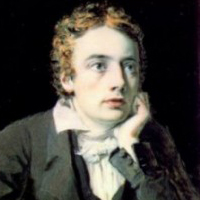The Eve of St. Agnes by John Keats: Summary and Analysis
The Eve of St. Agnes by John Keats was written in 1819 and published in 1820. This poem is taken as one of the finest and the most prominent in the 19th century literature. This poem is written in Spenserian stanzas: eight lines in iambic pentameter followed by a single line in iambic hexameter.

John Keats (1795-1821)
St. Agnes’s eve is the evening before the day on which the memory of St. Agnes is celebrated and fast is kept. The eve of St. Agnes is 20th January and the consecrated day in January 21st. The eve is called the vigil and the day is called the feast. And so St. Agnes eve is January 20th. St Agnes was a young Roman girl who became a convert to Christianity, and who was persecuted and finally she suffered death for her faith under the emperor Diocletian. She was subsequently canonized and declared a saint by the Christian church and a day was devoted to her memory.
The setting of the poem is a medieval castle, the time is cold January 20th, the eve of the Feast of St. Agnes. Madeline is assured that if she keeps fast and performs some special rites, she will have a clear vision of her lover at midnight. That is why she is impatiently waiting for the midnight to fall and goes to bed without supper as a ritual.
On this same evening, Porphyro, who is the lover of Madeline, comes to her castle without being noticed. Porphyro is regarded as the enemy by Madeline’s family and they want to kill him on sight. Luckily he meets Madeline’s old nurse, Angela, who is friend to Porphyro. She tells him the plan of Madeline and her belief on the ritual. He suddenly thinks of making Madeline’s dream a reality by his presence in her bedroom at midnight. He requests Angela to help her and also makes her believe that he will do no harm to her. Then she leads him to Madeline’s chamber and hides him in a closet.
Madeline in a beautiful thought of her lover to come in the dream enters her room and falls asleep. As expected, her fast and the ritual bring positive result. Her sleep becomes the sleep of enchantment and her lover Porphyro comes in her dream as if immortalized. After she falls asleep, he comes closer to her and awakens her by playing a lute. When her eyes open she was still in the grip of the magic spell of the wonderful dream. She lost the pleasure of her dream and she finds Porphyro in his ordinary form not in the immortal form like in the dream. She was so enchanted with the visionary Porphyro that she wanted him back. And her wish is granted. They got mystic marriage. The spell of the magic of the night came to an end. But, Madeline fears that he would leave her alone. To make her sure, he urged her to run away with him from the castle. Finally, they run away from the castle without anyone’s notice.
In The Eve of St. Agnes, Keats is not interested in the story or in the characters, but in the romantic love and its celebration. For him, romantic love is a heavenly experience and to give his romantic lovers this beautiful and enchanting experience, he puts them under the spell of magic. This narrative poem is full of supernatural elements which is one of the main features of romanticism.
This poem is descriptive in nature like a painting where every minute detail is vividly presented. The scene in the chamber is so colorfully explained that one can make the scene in his mind and feel the innate sensuousness of the poet. Every minute detail gives special contribution to praise the romantic love in the poem. Some critics compare this expression of romantic love to Keats’s love affair with Fanny Brawne.
The use of contrast in The Eve of St. Agnes by Keats is one of the dominant artistic devices implemented in the poem. The deliberate use of bitter cold contrasts with the warm love of Madeline and Porphyro. The love of Madeline and Porphyro is foregrounded against the hatred of Madeline’s family to Porphyro.
Though all the senses are enticed by the poet, the sense of sight is mainly attracted in the poem. The description of the stained window glass in the chamber of Madeline is the most beautiful example of his influential appealing power to the sight. This window was "diamonded with panes of quaint device, / Innumerable of stains and splendid dyes." Madeline is transformed into a "splendid angel" by the stained glass as the moonlight shines through it.
The death of Angela and the Beadsman at the end of the poem shows his abrupt and unfinished ending of the poem.
Cite this Page!
Sharma, K.N. "The Eve of St. Agnes by John Keats: Summary and Analysis." BachelorandMaster, 8 Aug. 2017, bachelorandmaster.com/britishandamericanpoetry/the-eve-of-st-agnes.html.
Related Topics
Ode to Autumn: Summary and Analysis
Ode on a Grecian Urn: Summary and Analysis
Ode to a Nightingale: Summary and Analysis
Ode to Psyche: Summary and Analysis
Ode on Melancholy: Summary and Analysis
Endymion: Summary and Analysis
Bright Star: Summary and Analysis
Le Belle Dame Sans Merci: Analysis
On First Looking into Chapman's Homer: Analysis
The Terror of Death (When I have Fears): Analysis
 |
bachelorandmaster.com |